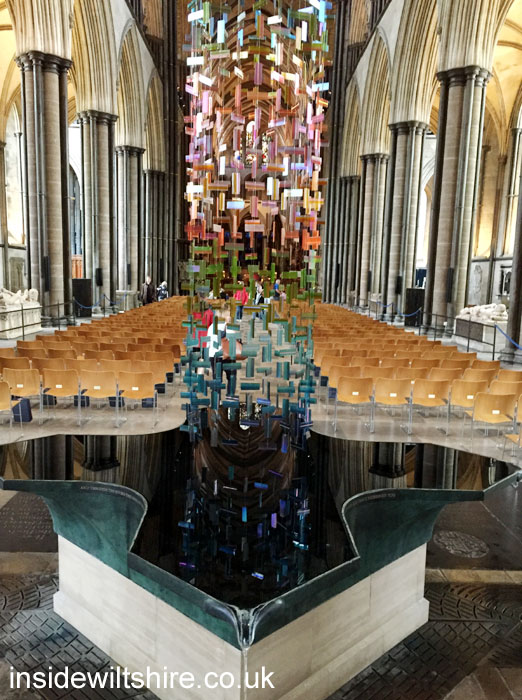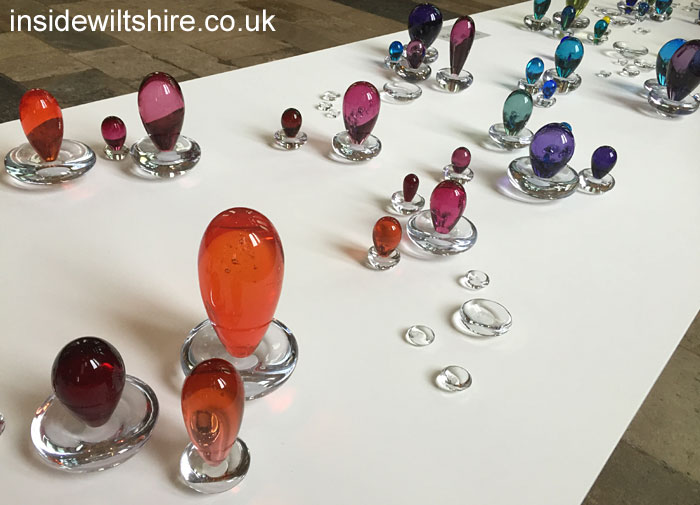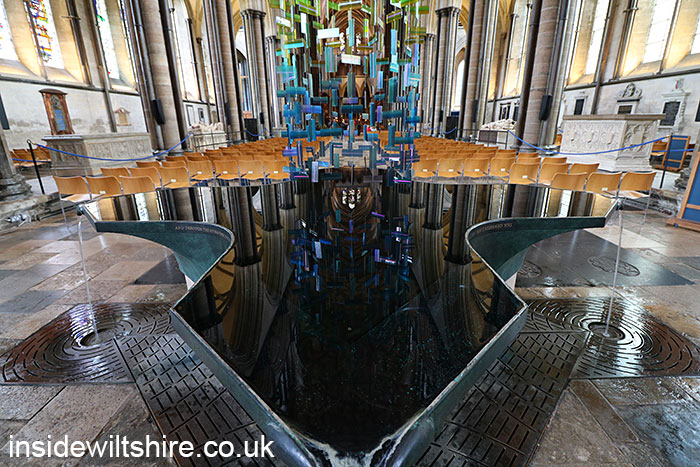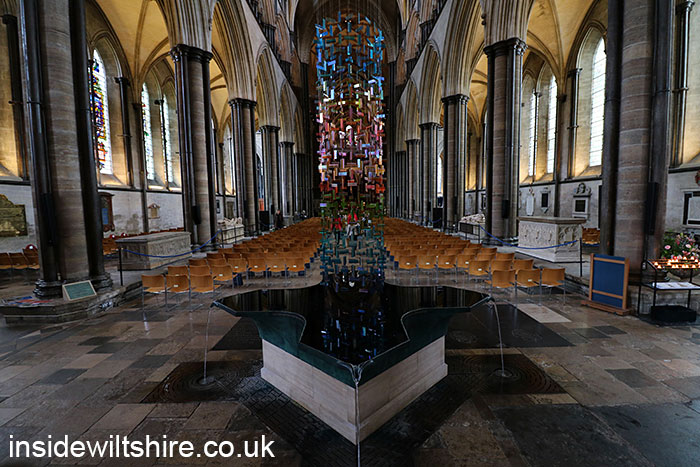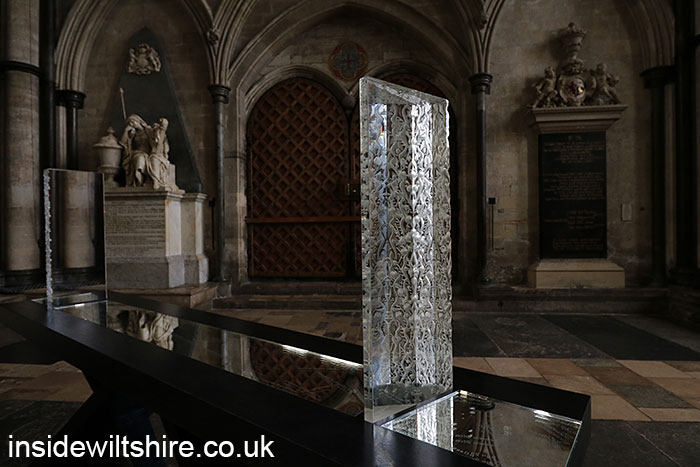The exhibition, featuring specially made pieces by nine internationally known artists, opens on 1 August and runs until November.
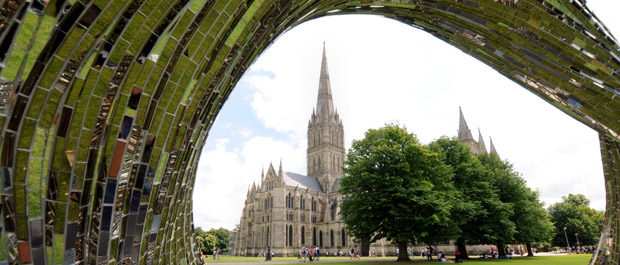
Salisbury Cathedral has long tradition of glass art, with some of its stained glass dating back to the 13th century and more modern windows like the astounding Gabriel Loire Prisoners of Conscience, which was installed in 1980. The elegant Early English Gothic architecture provides a perfect setting in which to show off these extraordinary works.
Reflection is curated by Jacquiline Creswell, Salisbury Cathedral’s Arts Advisor with Rebecca Newnham, a sculptor who works with glass. Jacquiline Creswell has been curating the Cathedral’s exhibitions for the past six years has also been responsible for acquiring pieces for the Cathedral’s permanent collection.
Co-curator Rebecca Newnham, an internationally known artist, has worked in Europe, America and the Middle East. Rebecca will also be showing two monumental pieces in the exhibition.
Exhibiting with Rebecca Newnham are Galia Amsel, Sabrina Cant, Amy Cushing, Sally Fawkes, Olivia Fink, Richard Jackson, Louis Thompson and Sylvie Vandenhoucke.
Rebecca said: “It is a privilege to co-curate this exhibition at Salisbury Cathedral with Jacquiline Creswell and one that I undertake mindfully. This is the second time I have been involved in an exhibition here and I have become familiar with the building’s majesty. I love the way the light filters through the vaulted glass windows, and the contrast between the solidity of the stone walls and the translucence of the glass. All nine artists featured in the exhibition use multiple glass components to create their installations, an approach which embraces the many remarkable qualities of glass and compliments the glorious setting.”
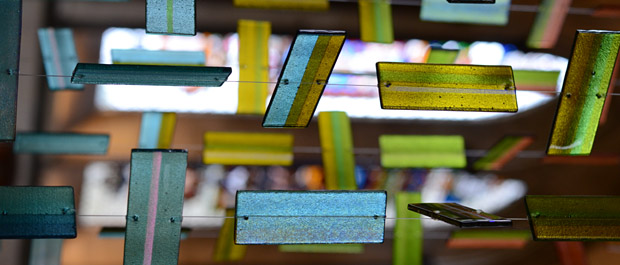
Artists exhibiting as part of the Reflection exhibition:
New Zealand based Galia Amsel is a graduate of the Royal College of Art (RCA). She employs a range of techniques in her glass making, from casting glass in a kiln, to polishing, to glass-blowing.
The piece Galia is showing as part of Reflection has its origins in a series of installations in a disused cement silo on the Auckland waterfront. One of these extraordinary pieces has been relocated to the Cathedral, with financial assistance from Creative New Zealand, and transformed in response to both its space and its size.
The original installation was connected to hoppers only 2.5 metres (just over 8ft) above the ground with the glass tubes descending to almost touch the ground; in the Cathedral it is suspended 3.5 metres (nearly 11ft 6 inches) above the floor.
Galia said: “My work references, via the contemporary apparatus of fibre optic cables, the historic use of glass in places of worship for the twin functions of lighting the spaces while transmitting profound ideas and spiritual narratives.”
Approaching glass as a simultaneously fluid and solid medium, Galia has developed a distinctive visual language. She often takes objects that have a particular use, whether mechanical, decorative or ritualistic and re-interprets them, whilst still preserving echoes of the original.
Since moving to Auckland in 2004 the quality of the light and the ocean have become significant influences in her work.
Inspired by celestial bodies and the natural world Sabrina Cant uses cast glass colours to achieve effects that are subtle, harmonious and occasionally mysterious with some pieces requiring up to 5 kiln firings before they are complete. Her interest in her own habitat and space is evident in her work which seeks to correspond to its environment.
Sabrina said: “My sculptures here respond to the Trinity Chapel stained glass colours, they are exhibited in their own space outside in the West Cloister in view of the spire. The plinths offer contemplation of a journey to the Heavens, while reflections from the black glass sections mirror the surrounding architecture the translucent glass pieces entice a view of their inner spiritual world. Two expanding cubes oppose a conflict of colour glowing a burning energy separated by the central icosahedron so often explored in gothic architecture connecting science and spirituality”
Amy Cushing’s first encounters with glass were in childhood when she observed her mother at work, using vitreous enamel and stained glass. Amy’s inspiration derives from the infinite emotions that colour evokes and the language it communicates.
Initially training in large scale mixed media for Public Art, Amy became frustrated by the lack of vivid colour in ceramic glazes and began fusing glass with clay, creating surprising results and eventually moved into kiln-formed glass because she preferred the graphic quality and luminosity. Most of her studio time is spent perfecting colour sequences and balance, using precious metallic coatings and leaf to show hidden depth.
Each artwork is developed considering its relationship with the space, in this case William Pye’s lovely flowing water font in the Cathedral Nave above which it will be suspended.
Amy said: “My installation is a modular piece attempting to enhance the experience of the font. It is a column of glass expressing a gradation of colour whilst catching the light and reflecting iridescence. I have drawn on colours from the nearby stained glass windows and emulated the columns through the nave. There are 594 sections of handmade glass loosely depicting the Cross. The artwork is not static; gradually moving to constantly catch and reflect the light adding endless possibilities to the composition, playfully interacting with the surface of the Font, dancing above the reflection created in the still water.”
From the start of her artistic career Sally Fawkes knew that glass was the material that would best translate her creative ideas. Just as visual perception is ambiguous, playing with levels of reality and imagination as the world around us is translated into pictures, so glass for Sally, glass conjures different possibilities and ever changing narratives from its surroundings. It is this ephemeral quality that both Sally and Richard Jackson, her collaborator and partner, are seeking to harness.
The work the Stroud based duo have created for Salisbury Cathedral sits within the Cloister Garth. The large scale piece is made of kiln formed glass, simultaneously solid and fragile, striving heavenwards. Designed to be seen from every aspect of the Cloisters – East, West,
North and South – it both reflects onto the ancient pillars and absorbs back their time-served solidity.
Sally and Richard said: “Our work is concerned with perception and interaction with spaces and places. We are interested in the layers of place, how history informs the present and how, in turn, people interact and respond to their surroundings. Our artwork is a three dimensional visual narrative; the overall image offers a sense of security whilst the various facets and elements will keep the eye moving. The steel structure suggests growth, rising from firm foundations, offering support whilst navigating the journey”
Livvy Fink lives and works in East London. Her work ranges in scale from environmental playgrounds to intricate works in hot and cold glass. She studied at the Royal College of Art and the University of Brighton, also learning Bohemian kiln cast glass techniques at the School of Applied Arts in Zeleny Brod, Czech Republic.
Inspired by the ability of the physical world to spark creative imagination, her glass work leads you to discover an unfamiliar landscape made up of complex but familiar forms: frozen moments occurring somewhere between liquid and solid states, where passing light is fragmented by a myriad of intricate surfaces suspended within the glass.
Livvy skilfully employs phosphorescence in her work to represent bioluminescence of living organisms. Her work here has a technical relationship to the Whistler glass prism which forms part of the Cathedral’s collection.
Livvy said: “I have explored the dramatic but intricate scale of the Cathedral and the effect this has on experience an interesting idea to work with, extending the idea of changes of scale and linking my work to the fabric of the building by using light to create larger shadows that emanate from the glass piece itself.”
The Bournemouth based sculptor, Rebecca Newnham, is a member of the Royal British Society of Sculptors and has received awards from, amongst others, the Arts Council of England. She studied for her MA at the Royal College of Art and worked with Packman Lucas, esteemed structural engineers, to create technically challenging floating and kinetic installations. She has exhibited at the Cathedral before as part of our Liminality 2010 exhibition and shows widely in the UK, including at Saatchi and Andipa Galleries in London. Her work was shown alongside Henry Moore, Barbara Hepworth and others in the 2012 exhibition The Figure in the Landscape at Winchester Discovery Centre.
Rebecca’s knowledge and understanding of glass is one of the reasons why she is co-curating the Reflection exhibition for Salisbury cathedral, which includes two of her own monumental pieces.
Rebecca said: “It is a privilege to exhibit at Salisbury Cathedral. The contrast between the solidity of the stone walls and the ethereal translucence of the glass is mesmerising and the flat lawns of the Close emphasise the sheer vertical height of the carved façade and make every approach thrilling. My work for the interior considers the way sound radiates from the Choir and the two curves represent a captured acoustic moment in time, still but shimmering with energy and vibrancy. The black glass surfaces are highly reflective and as the viewer moves the reflected images scintillate in thousands of pixels.
“Launch, which will stand on the West lawn, is a tall arched sculpture with a glass mosaic skin, its location chosen to allow it to frame a specific view of the cathedral. The glass is applied so as to flow like plumage, like a magnificent bird, showing the immense energy required to take off from a stationary position and elevate like a swan taking flight from a calm lake.”
Louis Thompson lives and works in London and was a scholarship student at Pilchuck GlassSchool in the state of Washington, USA. He completed his Masters Degree at the Royal College of Art in 2011 and has since worked with and taught glass artists both in the UK and abroad. He has attended Master classes with Petr Novotny, Josiah McElheny, Jan Eric Ritzman, Ben Moore and Dante Marioni.
In 2012 Louis received two prestigious awards: the Jerwood Makers Prize Commission and the Best Exhibit Prize at the British Glass Biennale. His work has been shown around the world and he has been invited to create installations for various museums and international exhibitions including the International Exhibition of Glass in Kanazawa, Japan in 2010, COLLECT at the Saatchi Gallery, London, and SOFA, Chicago, in 2013. In 2014 he exhibited at the Glazenhuis Museum in Belgium, where he also completed a residency and was selected for the European Glass Prize Exhibition in Coburg, Germany.
Louis said: “My work here is concerned with ideas of repetition, sequence and multiples, exploring colour to investigate ideas concerned with capturing memories or moments in time. Memories of my physical actions on glass, sometimes sabotaging the material, twisting, creasing, buckling and collapsing are fundamental in how I explore scale, composition and material quality. There are underlying themes of the human body, sensuous and tactile, echoing folds, curves and creases.”
The work Belgian born Sylvie Vandenhoucke works in a range of materials such metal, paper, carpet and glass, which she has worked with and researched intensively. Focusing on elements such light and space, duration and flux, she is interested in the ‘play’ of light within her work.
For Sylvie the subtle optical changes of surfaces and materials provoke exploration of the boundaries of the visible and invisible, reality and imagination.
Sylvie said: “In the empty spaces of the North Aisle Quire a series of frames, coated with very fine clear glass frit (or tiny chips of glass) draws on the history of the cathedral and its ever changing and evolving configurations, where the interior has been repeatedly reorganised. In the North Aisle Nave area three more frames continue the flow of memorial plaques nearby.”
